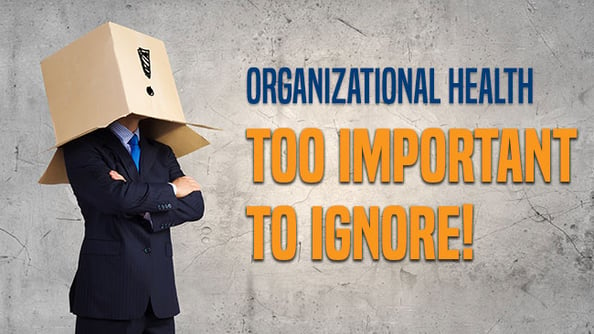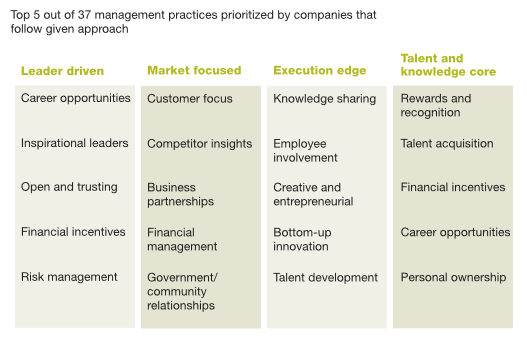Financial success is not the sole indicator of a healthy organization. In fact, it’s more an outcome of a healthy organization. Let me explain --

Many agencies know how to be successful in the short term, but spend less time focused on how they will sustain that success over the long term.
By the way, if you think your business can stand still and maintain while you're saying — I’ll get to that, I just don’t have time right now…
I’ve got to break it to you. There’s no such thing as maintaining your ground in business these days.
If you aren’t growing, you’re dying…
And your agency’s organizational health will tell you which direction you’re moving.
What exactly is organizational health?
Organizational health has been part of business conversation for years, but what it is can still be tricky to pin down. This could be because it involves so many different areas of a business and many people think, why bother, because there’s no way to measure or take action to improve organizational health.
But as you’ll read in this blog post, that may not be the case.
First, these three explanations will help give you a 360-degree view of what organizational health entails.
Teamworks explains it by identifying a few areas in your business that require your attention when you work on improving your organizational health. They include:
- Profitability
- Revenue Growth
- Customer Satisfaction
- Culture
- Strategic Plan
- Team Architecture
- Innovation
- Acquisitions
- Rewards
- Purpose and Passion
Now that you know which areas to focus on, how do you bring it all together?
Organizational Health offers this concise definition: an organization’s ability to function effectively, to cope adequately, to change appropriately, and to grow from within.
And as McKinsey & Company summarizes it, the health of an organization is based on the ability to:
- Align around a clear vision, strategy, and culture
- Execute with excellence and efficiency
- Renew the organization’s focus over time by responding to market trends and remaining relevant through innovation
There’s never a good time to take your eye off the prize (profitability) and we understand that, but there is plenty of evidence to back up the value in organizational health.
This is why we encourage the agencies we work with to consider looking at these other facets of their business, if they want to thrive for years to come and have something to pass on to family… or to sell.
If you haven’t already been assessing your organizational health and working to improve it, the next best time to start is now.
Why does organizational health matter now more than ever?
With the competitiveness of the market and the easy access to information and resources, what sets one insurance agency or IMO apart from another is how their business is ran internally.
This is not only the case in our industry, but across others as well.
"Research from Chris Zook and James Allen of Bain, (authors of The Founder’s Mentality) has shown that 94% of business challenges are internal." (Source)
In contrast, 15-20 years ago, business development challenges were more external — i.e. needing new technology, supply chain, etc.
However, focusing efforts on organizational health isn’t just to gain a competitive edge, it’s the key to staying in business at all.
A healthy organization is more likely to be able to compete not only today but tomorrow. It’s just as important as our own health, which is our greatest asset. If we let is slowly deteriorate, before we know it – our time will be up.
Same goes with a business. It will eventually sputter out and die without attention to overall health.
How does improved organizational health deliver greater business results?
McKinsey & Company has done extensive research and found that, “companies that work on their health, not only achieve measurable improvements in their organizational well-being but demonstrate tangible performance gains in as little as 6 to 12 months.”
Three of their core findings:
- Almost all companies perform better if they improve their health.
- The unfit are the most likely to make the biggest health advances.
- Those at the top achieve the biggest financial rewards.
These findings indicate that whether your business is doing phenomenally well, on the brink of failure, or somewhere in between, you can benefit from improving health.
Performance management software company, 15Five, references the book by McKinsey & Company directors, Beyond Performance: How Great Organizations Build Ultimate Competitive Advantage, in describing the benefits of thinking beyond just performance.
“[The authors] studied two groups at a large financial-services institution that were representative of the entire organization in terms of profit, customer economics, and branch characteristics. One group implemented a long-term sales stimulation program using traditional, performance-focused methods. The other utilized an approach for the same time period that balanced performance with health. Growth in the first group was 8%, while the other group had incredible 19% growth.”
If you want to see results in your agency or IMO, you have to find a way to implement healthy best practices. McKinsey & Company describes four health organizational clusters that came out of their analysis of organizations in their database. But, as they pointed out, these combinations or “recipes” can and should be tweaked to fit your own organization.
They’ve outlined, in the chart below, key practices for leader-driven, market-focused, execution-edge or talent and knowledge archetypes and the corresponding practices those archetypes would employ to improve organizational health.
The healthiest companies in their database implemented these practices to achieve higher scores on the organizational health index.

Source: The hidden value of organizational health — and how to capture it. Aaron De Smet, Bill Schaninger, and Matthew Smith. April 2014. https://www.mckinsey.com/business-functions/organization/our-insights/the-hidden-value-of-organizational-health-and-how-to-capture-it.
With an increase in competition, it’s crucial to consider areas of development, such as organizational health, that we may not have thought of before. Or may not have HAD to think of before because we could compete in other ways.
What are next steps?
As this article points out, “Companies often underestimate how important organizational health is, and don’t give it the same level of priority as overall performance. But there is a direct correlation between companies that prioritize their health and organizations that stay successful.
An organizational check-up entails taking inventory of your company’s functionality, systems, and culture.”
Now, we’re not suggesting you abandon your attention to performance because all businesses need to mind the bottom line.
Scott Keller and Colin Price, directors at McKinsey & Company, explain in this article how a company can take action to improve organizational health as well as performance.
They’ve developed a process called the 5As:
· Aspire (where do we want to go?) is about setting overall performance goals and the health aspirations that will enable them to be achieved.
· Assess (how ready are we to make the journey?) is about determining what capabilities and shifts in underlying mindsets are needed to reach the aspirations.
· Architect (what do we need to do to get there?) is about developing a portfolio of initiatives to improve performance and planning how to implement them to shape the desired mindsets and behaviors.
· Act (how do we manage the journey?) is about adopting the right scaling-up model, using governance to ensure broad ownership, and measuring performance and health rigorously throughout.
· Advance (how do we keep moving forward?) is about establishing the mechanisms and building the leadership capacity to drive continuous improvement.
Final thoughts
When we go about fixing organizational health, it can be much like trying to improve our personal health.
It’s easy to end up treating symptoms (popping a pill, putting on a band-aid) rather than addressing the underlying causes (eating nutritious foods and exercising).
But it’s the willingness to delve into those underlying causes of poor organizational health that will differentiate those in it for the long-term from those who’ll only be around for a short a time before they disappear.
At Partners Advantage, we’re embracing a holistic approach to business and consulting with those agencies we work with to help them grow in profitability, develop a long-term strategic plan, and boost the overall health of their organization. You can find out more here:






